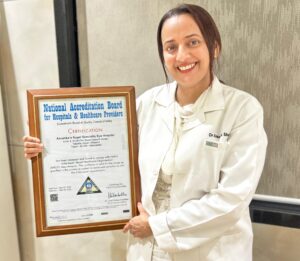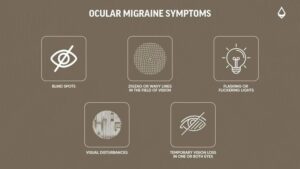
Anushka Super Speciality Eye Hospital
Call: 90044 44422 / 99213 44422 | Timings : 8.30 a.m to 5.30 p.m (Mon-Sat) | Add: Shri Swami Samarth Soc, Kaneri Dhamankar Naka, Bhiwandi




Accredited for Quality Care
Latest Refractive Surgeries: LASIK, SMILE, FEMTO and Beyond – A New Era of Clear Vision
anushka
16 October 2025
For decades, wearing glasses or contact lenses was the only solution for those suffering from refractive errors like myopia (nearsightedness), hypermetropia (farsightedness), or astigmatism. But modern eye care has evolved dramatically. Today, advanced refractive surgeries like LASIK, SMILE, and FEMTO LASIK are offering millions the chance to live life free from the constant dependency on glasses.
At Dr. Anushka’s Super Speciality Eye Hospital, Bhiwandi, we bring world-class technology and NABH-accredited safety standards to every refractive surgery — ensuring precise outcomes, faster recovery, and lasting comfort.
Let’s explore how these cutting-edge procedures are changing lives — and which one might be the best for you.
Understanding Refractive Errors
Before diving into the surgeries, it’s important to understand what refractive errors actually are.
Your eye works much like a camera. Light enters through the cornea, passes through the lens, and focuses onto the retina. If this focus point is off — either in front of or behind the retina — vision becomes blurry.
The common refractive errors include:
- Myopia (Nearsightedness) – Distant objects appear blurry.
- Hypermetropia (Farsightedness) – Near objects appear blurry.
- Astigmatism – Vision is distorted due to irregular corneal shape.
- Presbyopia – Age-related difficulty in near vision (usually after 40).
Refractive surgeries reshape the cornea to correct how light bends inside your eye — restoring perfect focus without glasses.
1. LASIK – The Classic Vision Correction
LASIK (Laser-Assisted In Situ Keratomileusis) is one of the most widely performed and trusted laser vision correction procedures.
It’s known for its accuracy, comfort, and quick recovery.
How LASIK Works
- A thin corneal flap is created using a microkeratome blade or femtosecond laser.
- An excimer laser then reshapes the underlying corneal tissue.
- The flap is gently repositioned without the need for stitches.
Advantages of LASIK
- Vision recovery within 24–48 hours
- Painless and bladeless in modern versions
- Treats myopia, hypermetropia, and astigmatism
- Permanent and stable results
Is LASIK Right for You?
You may be a candidate if:
- You are above 18 years
- Your eye power is stable for at least 1 year
- Your cornea has adequate thickness
- You have no major eye disease like keratoconus
LASIK has one of the highest success rates in eye surgery, with more than 95% patients achieving 6/6 vision or better.
2. SMILE – The New-Generation Laser Vision Correction
SMILE (Small Incision Lenticule Extraction) is the most recent innovation in laser refractive surgery.
It is minimally invasive, flapless, and blade-free — ideal for those looking for quicker healing and less dryness.
How SMILE Works
- The femtosecond laser creates a small lenticule (lens-shaped disc) within the cornea.
- The surgeon removes this lenticule through a tiny 2 mm incision.
- The cornea changes shape, correcting the refractive error.
Benefits of SMILE Surgery
- No corneal flap → Less dryness and stronger corneal structure
- Faster healing and minimal discomfort
- Suitable for people with active lifestyles or sports professions
- Lower risk of post-operative complications
SMILE vs. LASIK
Feature | LASIK | SMILE |
|---|---|---|
Flap creation | Yes | No |
Incision size | 20 mm | 2–3 mm |
Post-op dryness | Slightly more | Much less |
Recovery | 1–2 days | 1 day |
Suitability | Myopia, Astigmatism | Myopia, Mild Astigmatism |
SMILE is often called the “next-gen LASIK”, offering freedom from glasses with even fewer side effects.
3. FEMTO LASIK – The Blade-Free Precision Surgery
FEMTO LASIK (Femtosecond Laser-Assisted LASIK) combines the safety of femtosecond laser flap creation with the accuracy of excimer laser correction.
It’s 100% blade-free, offering superior precision and safety compared to conventional LASIK.
How FEMTO LASIK Works
- The femtosecond laser creates a precise corneal flap.
- An excimer laser reshapes the cornea to correct the vision.
- The flap is repositioned to heal naturally.
Advantages of FEMTO LASIK
- Greater accuracy and customized flap thickness
- Reduced chances of flap complications
- Perfect for patients with thinner corneas
- Fast recovery and improved night vision
FEMTO LASIK represents a perfect balance between traditional LASIK and advanced SMILE — making it one of the most preferred procedures worldwide.
4. Contoura Vision LASIK – Personalized to Every Eye
This is one of the most advanced LASIK technologies, also known as Topography-Guided LASIK.
Contoura Vision maps 22,000 unique points on your cornea to create a personalized laser profile for your eyes.
Key Highlights
- Corrects not just power, but also corneal irregularities
- Delivers sharper, HD-like vision
- Reduces glare and halos during night driving
- Often gives better-than-6/6 vision
If your goal is not just freedom from glasses, but super vision clarity, Contoura LASIK is the ideal choice.
5. PRK (Photorefractive Keratectomy) – The First Laser Vision Surgery
Before LASIK existed, PRK was the pioneer in laser eye surgery. It’s still used today for patients who have thin corneas or are unsuitable for LASIK.
Procedure Overview
- The top epithelial layer of the cornea is removed.
- The excimer laser reshapes the corneal surface.
- A soft contact lens is placed to aid healing for 3–5 days.
Pros and Cons
- No flap → safer for thin corneas
- Slightly longer recovery time (5–7 days)
- Excellent long-term vision results
PRK remains a reliable, cost-effective solution when LASIK or SMILE is not advisable.
6. ICL – Implantable Collamer Lens
For patients whose corneas are too thin for laser correction, ICL (Implantable Contact Lens) offers an excellent alternative.
Procedure
A soft, biocompatible lens is implanted inside the eye — between the iris and the natural lens — providing permanent vision correction.
Benefits
- No removal of corneal tissue
- Reversible and safe
- Ideal for high myopia or thin corneas
- Quick recovery and superior clarity
ICL surgery is sometimes called “permanent contact lenses” — you don’t feel them, but you see perfectly.
Choosing the Right Surgery – What’s Best for You?
The choice of procedure depends on multiple factors:
- Age and eye power stability
- Corneal thickness and shape
- Lifestyle (sports, profession, etc.)
- Pre-existing eye conditions
At Dr. Anushka’s Super Speciality Eye Hospital, every patient undergoes a detailed preoperative evaluation using high-end diagnostic systems like the ARGOS biometer and corneal topography before recommending the right procedure.
Our goal is personalized vision correction, not just removing glasses.
Life After Refractive Surgery – What to Expect ?
After laser surgery, most patients enjoy dramatic improvement in vision within a day or two.
Here’s what a typical recovery looks like:
- Day 1–2: Mild dryness, light sensitivity, or foreign body sensation
- Day 3–5: Vision becomes clearer and more stable
- 1 Week: Most resume regular activities
- 1 Month: Vision stabilizes completely
Following your doctor’s post-op advice ensures long-term results and healthy eyes.
Post-Operative Care Tips
- Use prescribed eye drops regularly.
- Avoid rubbing or touching your eyes.
- Wear UV-protective sunglasses outdoors.
- Avoid swimming or eye makeup for 2 weeks.
- Attend all follow-up checkups diligently.
With proper care, your results can last a lifetime.
FAQs on LASIK, SMILE, FEMTO, and Refractive Surgeries
Q1. Is LASIK painful?
No, LASIK is completely painless. Numbing drops are used before surgery, and most patients feel only mild pressure.
Q2. How long does the surgery take?
Each eye takes only 10–15 minutes. The entire process is done in one sitting.
Q3. Can both eyes be treated on the same day?
Yes, both eyes are treated in the same session for convenience and faster recovery.
Q4. Is SMILE better than LASIK?
Both are excellent. SMILE is flapless and minimally invasive, ideal for those with dry eyes or active lifestyles, while LASIK offers wider correction range and is more versatile.
Q5. How soon can I return to work after surgery?
Most patients resume work in 24–48 hours, though rest for a day is recommended.
Q6. Are results permanent?
Yes, results are generally permanent unless there are age-related changes like presbyopia later in life.
Q7. Can I get LASIK if I have thin corneas?
If corneas are too thin for LASIK, SMILE, PRK, or ICL may be safer alternatives.
Q8. How safe are these surgeries?
Refractive surgeries have a success rate over 98%, especially when done with NABH-approved safety protocols and advanced lasers.
Q9. What is the cost of LASIK or SMILE surgery in India?
Costs vary depending on the technology used, but generally range from ₹35,000 to ₹90,000 per eye depending on the procedure type and customization.
Q10. Do I need glasses after surgery?
In most cases, patients achieve 6/6 vision and never need glasses again. However, reading glasses may be needed after age 40 due to presbyopia.
Q11. Can I undergo LASIK after cataract surgery?
In some cases, yes — but this requires a detailed evaluation by your ophthalmologist.
Q12. Is laser surgery safe for teenagers?
No, refractive power should be stable for at least 1 year before undergoing LASIK or similar surgeries. Usually, after age 18 is ideal.
Conclusion: A Clear Vision for a Clear Future
Refractive surgery is more than just laser—it’s freedom, confidence, and a new way of life.
At Dr. Anushka’s Super Speciality Eye Hospital, Bhiwandi, our expert team and state-of-the-art laser systems ensure safe, personalized, and precise vision correction for every patient.
Whether you choose LASIK, SMILE, FEMTO, Contoura, or ICL, your dream of living glasses-free is just one step away.
Trust the experts. Trust technology.
Step into a clearer, brighter future — today.
Recent Posts


